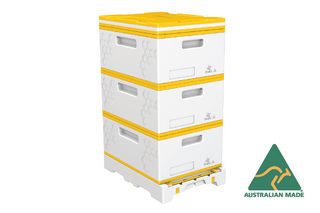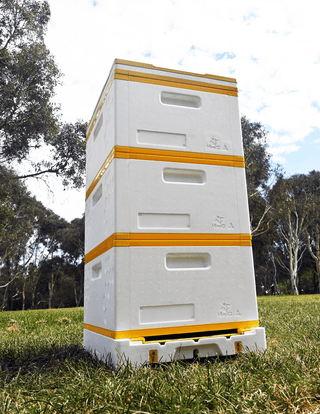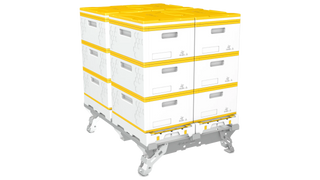In the world of beekeeping, there has always been a threat that beekeepers noticed – excessive condensation. Especially in cold climates, condensation forming in the wrong places can have dire consequences for bee colonies. Based on the scientific principles of natural thermodynamics, the condensing hive design is here to revolutionise beekeeping, providing a host of benefits that not only protect our bees but also make our beekeeping endeavours more efficient and sustainable.
Key features of a condensing hive:
- A continuous high R-value insulation covering the sides, bottom and top
- Superior heat retention by elimination of top ventilation, gaps or holes between the hive bodies
- They allow for a natural convection cycle where ventilation and the elimination of excess moisture occurs at the bottom entrance or floor.
- The bees have access to needed water droplets from harmless condensation that forms away from the top of the cluster and in areas below the cluster.
- The bees control the hive environment naturally without the need for beekeeper intervention.
The condensing hive advantage:
- Protecting our precious pollinators.
Condensation occurring above the colony poses a significant danger to bees, particularly in cold climates. With the condensing hive design, warm, humid air rises from the cluster and contacts the hive ceiling. However, because the temperature of the hive ceiling is above the dew point, instead of condensing and dripping back onto the bees, the humid air spreads out and condenses on cooler surfaces away from the cluster and around the outside walls. This feature ensures that condensation occurs below the colony or outside the hive, preserving the health and vitality of our bee colonies.
- Winter survival boost
One significant advantage is a condensing hive’s ability to reduce or even prevent the risk of starvation. Bees require fewer food stores to generate the heat energy necessary to keep warm. This means that even in the coldest climates, an adequately provisioned colony can thrive while using fewer food resources.
- Immune system support
Research indicates that a naturally balanced hive environment aids bees in combating pathogens. Natural condensing colonies allow bees the opportunity to maintain an ideal hive environment that supports a bee’s immune system.
- Preserving hive infrastructure
Excessive moisture in the hive results in mould growth on the hive walls, frames and comb as shown below, which creates a high overhead for the colony to clean and repair damaged comb before they can use it. In contrast, the majority of warm, humid air condenses low down or outside the hive.

Wooden bee frames are a crucial component of many beehives. With the condensing hive, they stay dry and in pristine condition, avoiding the dark black stains associated with water and moisture damage. The dark stains indicate that your frames are becoming waterlogged, which is a haven for unhealthy mould and disease and causes the frames to expand with moisture, which can make it difficult to remove frames without rolling and killing your queen and bees. The dry environment inside a condensing hive not only prolongs the life of the frames but also maintains a healthier environment for the bees.
Tips to ensure your bees survive the cold winter period.
Insulate - If you don’t have an insulated hive, be sure to wrap your hive in insulation to protect your bees from the elements.Make sure they have plenty of stores – Leave plenty of honey stores for the bees. If your colonies are lacking in honey stores, feed them sugar syrup before the winter sets in to enable them the build up sufficient stores.
Space optimisation - Remove any unnecessary supers from the colony is imperative. This provides the bees with just the right amount of space to keep warm without expending excessive energy.
Ensure the hive top and supers are sealed - A well-fitting hive top is crucial for the correct thermal performance and the hive’s overall integrity. Cold air entering the hive through any gaps can reduce the ceiling temperature to below dew point, which results in condensation forming and dripping on your bees. Unnecessary vents and gaps in the top of the hive also allows valuable heat energy to escape, leading to high consumption of honey stores by the colony to replace lost heat energy. Be sure to periodically check for any propolis or wax buildup that might prevent your hive top and supers from providing a proper seal. Strapping the hive and hive top firmly together guarantees a tightly sealed hive.
Shielding from the elements - High winds can be detrimental to a hive’s wellbeing. To counter this, placing a wind barrier such as a row of bricks or timber boards around the hive base is recommended to prevent cold winds from flowing under the ventilated floor, which can force cold air into the hive.
Embracing the innovation of condensing hives, including our HiveIQ hives, represents a monumental advancement for beekeepers. They not only safeguard our bee colonies from condensation related issues but also reduce the risk of starvation, bolster disease resistance and preserve the integrity of our hives. To find out more about our condensing hives contact us.
Also read: What is a Condensing Colony?




